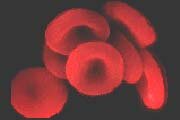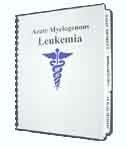 |
||
| HOME | ||
 |
||
| Acute Myelogenous Leukemia (AML) |
||
 |
||
| Other Leukemia Types (ALL / CLL / CML / HCL) |
||
 |
||
| Myelodysplastic Syndrome | ||
 |
||
| Symptoms and Diagnosis | ||
 |
||
| Leukemia Treatment Options | ||
 |
||
| " Chemotherapy | ||
 |
||
| " Blood Stem Cell Transplants | ||
 |
||
| " Radiation and Surgery | ||
 |
||
| " Chemo Side Effects | ||
 |
||
| " Clinical Trials Info | ||
 |
||
| " Coping with Leukemia | ||
 |
||
| " What to Ask Your Doctor | ||
 |
||
| Financial Assistance | ||
 |
||
| At Risk Jobs/Exposure | ||
 |
||
| Leukemia Resources | ||
 |
||
| Survivor's Story | ||
 |
||
| Leukemia News | ||
 |
||
|
Search for information:
|
||

|
Leukemia Cancer News - Return to Menu Drug offers surprise against cancer Marilynn Marchione ORLANDO - May. 16, 2005 - Revlimid, a drug found effective against myelodysplatic syndrome, is similar to thalidomide, a drug notorious for the birth defects it caused decades ago but that in recent years has proved effective against another blood cancer, multiple myeloma. Researchers don't really know how it works other than that it boosts the immune system in a number of ways. "It's a serious problem, it tends to occur in older people, and it's fatal for most," Dr. Herman Kattlove, a blood disorder specialist at the American Cancer Society, said of myelodysplastic syndrome, or MDS. In small studies, Revlimid also showed promise and with far fewer side effects. In a new study, doctors tested it on 115 people with MDS who have the most common chromosome abnormality that causes the disease. advertisement After about six months on the drug, 66 percent no longer needed blood transfusions, said the study's leader, Dr. Alan List of the H. Lee Moffitt Cancer Center in Tampa. A year later, three-fourths of them still don't need transfusions. But the big surprise was that signs of the genetic mutation fueling the disease diminished in 81 patients and vanished in 51. "The chromosome abnormality completely disappeared, something we've never seen before" from a drug aimed just at boosting red blood cells, List said. Dr. Bruce Johnson of the Dana-Farber Cancer Center in Boston compared it with what doctors saw in early tests of the drug Gleevec on people with chronic myelogenous leukemia several years ago. "If you extrapolate what they saw, it's one of the signs for long remission," he said of the abnormality's disappearance. Dr. Jasmine Zain, a blood specialist from the City of Hope Cancer Center in New York, said the results warrant further testing. "Nowhere do you see 60 to 70 percent responses," she said. About one-third of people on the drug had temporary drops in other blood cells and clotting components, fixed by briefly interrupting treatment or lowering the dose. The study was sponsored by Celgene Corp., which makes Revlimid. List is a consultant for the company and reported results Sunday at a meeting of the American Society of Clinical Oncology in Orlando. Chromosomal Hotspots Targeted by Cancer Chemotherapy Lead to Leukemia NEW YORK APR 13, 2005 (Reuters Health) - Chemotherapy drugs that inhibit topoisomerase II mediate the formation of chromosomal translocation breakpoints at DNA hot spots, according to a report in the April 14th issue of the New England Journal of Medicine. Chimeric fusion of nonhomologous DNA strands that confers a proliferative or survival advantage in a hematopoietic progenitor can then lead to leukemia. "There is very little information on how chromosomes break and rearrange to give rise to leukemia," senior author Dr. David Grimwade told Reuters Health. One clue, he said, lies in the observation that a small minority of cancer patients exposed to topoisomerase II inhibitors -- such as doxorubicin, mitoxantrone, and etoposide -- are more prone to secondary leukemia. Normally, topoisomerase II relaxes supercoiled DNA by cleaving and then "stitching the ends back together," the researcher explained. This process appears to be impaired after treatment with inhibitors of the enzyme. Dr. Grimwade, of Guy's, King's, and St. Thomas' School of Medicine in London, and his colleagues examined genomic breakpoints in the promyelocytic leukemia (PML) gene on chromosome 15 and the retinoic acid receptor-alpha (RARA) gene on chromosome 17 in six patients who developed secondary acute promyelocytic leukemia (APL) following treatment with mitoxantrone. Breakpoints in four patients were clustered in an 8-base pair region at positions 1482 to 1489 in the PML intron 6 gene. There were similar breakpoints in the RARA gene. When DNA was heated, cleavage at other sites was reduced or eliminated, while those induced at DNA hotspots by mitoxantrone remained detectable, indicating that the cleavage complex was "preferred and stable." After DNA in the two genes is cut, "the DNA repair pathway makes a mistake and stitches together the two chromosomes," instead of rejoining the ends of the same gene, Dr. Grimwade continued. The cell in which that occurs "does not die, (instead) the PML-RARA protein gives cells a survival advantage" that leads to leukemia. A fifth patient who developed APL after treatment with etoposide and doxorubicin demonstrated similar abnormal chromosomal repair at breakpoint junctions. "These results suggest that topoisomerase II-mediated cleavage is a general mechanism causing DNA damage in APL that develops after treatment with various agents that target topoisomerase II," Dr. Grimwade's team concludes. In a related editorial, Dr. Jens Pedersen-Bjergaard of the Cytogenetics Laboratory at Rigshospitalet, Copenhagen, observes that after more than 30 years of comprehensive research on therapy-related myelodysplasia and AML, "these diseases now provide new insights into the molecular biology of myelodysplasia and AML in general." SOURCE: New England Journal of Medicine 2005;352:1529-1538,1591-1594.
|
|
|


